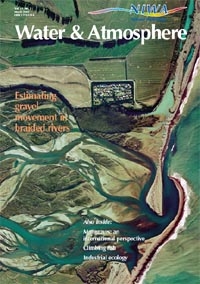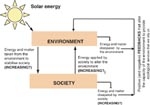PDF of this article (115 KB)

Guy Penny
NIWA is becoming involved in new research areas aimed at addressing the problem of how to restore the balance between society and nature.
Industrial ecology is a relatively new, multi-disciplinary research area, which examines the relationship between economic activities, society and nature. It applies principles of ecology to contemporary society, treating society like an ecosystem with a defined boundary, inputs, outputs, components, regulators, internal flows, transformations and feedbacks of energy and materials. For a full range of topic areas, visit the Journal of Industrial Ecology website.
This article outlines the principles that underpin industrial ecology and introduces some work that NIWA has recently started.
Principles of industrial ecology
Over thousands of years humans have developed a remarkable capacity to control energy and matter to create modified ecosystems – such as cities and farms – to support our cultural and metabolic needs and most decadent desires. As societies have “developed” and population has grown, we have increasingly diverted energy and materials away from their natural organisation, and the ecological services we rely on, toward technical activities that stabilise society. This has provided society with many benefits, but has also contributed to many environmental problems that are increasingly appearing as economic and social costs. Examples for New Zealand include the cost of the current painted apple moth eradication programme in West Auckland (approximately $90 million) and damage and losses due to Cyclone Bola in 1987 (approx. $200 million).
These simple examples are symptoms of human-induced changes to natural energy and material “states of order”. Along with thousands of other such examples, they cumulatively have an impact on global environmental change.
The underlying principle is that we do not consume energy, but transform high-grade energy into waste heat that is dissipated into the environment. And we do not consume resources but alter the organisation of matter, relocating and rearranging it and discarding into the environment parts of it that are not of immediate value. According to the first law of thermodynamics, the law on conservation, we consume states of order, not matter (see panel below).

The relationship between society and environment can be described as existing in a state of (thermo)dynamic equilibrium (see diagram). Increasingly, however, energy and matter imbalances between society and nature are leading to widespread environmental changes. As natural capital (renewable and non-renewable resources and ecological services) is transferred to social capital (knowledge, skills, organisational and adaptive capacity) and economic capital (wealth generated via economic activity), the environment is becoming increasingly unstable as it loses its capacity to fight entropy (disorganisation or chaos). This can be expressed through the second law of thermodynamics, the entropy law (see second panel below).
We are now dissipating so much energy and disorganised matter into the environment that we are undermining the capacity of the global environment to maintain the state of order required to produce the ecological services upon which we rely for our basic needs. (See the right-hand feedback loop in the flow diagram to the left.) We have set in motion a positive-feedback energy and materials cycle between society and nature, which is unsustainable because the two systems are evolving at different speeds. This creates a major problem for society.
It is important to start addressing this positive feedback cycle if we want to prevent a new equilibrium with reduced social, economic and natural capital. To do this requires changes to our current energy generation and use, and associated changes to industrial processes and resources consumption patterns. Such changes should account for the effects and by-products of all processes and how they feed back to alter states of order in the environment and society. Industrial ecology offers some useful models in this regard.
Industrial ecologists recognise that ecological sustainability of living systems (including societies and agricultural ecosystems) is related to their compatibility with surrounding environment and their ability to maintain their organised pattern in the face of changing environmental conditions. An example of measuring the ecological sustainability of changing agricultural land-use systems is shown in the panel below.
Determining the costs of change: a collaborative exercise
Despite a number of important international and national policy initiatives resulting from the Rio Earth Summit of 1992, in the 10 years following the Summit there have been few significant changes to achieve sustainability at a global scale. This is partly because of a failure to quantify the costs of change – now regarded as essential in any change towards sustainable development. The costs of change are highly specific to regions, industries, organisations and communities, so partici-pation in the research by those for whom costs are being determined is vital.
To date, there are few examples where the specific costs of adaptation to more sustainable practices have been determined for New Zealand industries, organisations or communities. There were minor improvements in energy efficiency during the 1990s (the ratio of energy consumption to GDP fell approximately 2% per year, though per capita energy consumption remained static). However, according to OECD statistics, New Zealand remains less energy and resource efficient than most OECD countries. Thus it seems prudent to start investigating the costs of improving the efficiency of energy and material transformations. NIWA is now involved in this, in two new research areas.
NIWA is working closely with businesses and government agencies in the transport sector to begin determining the social and economic costs of changes to the transport sector under a range of cleaner and energy-efficient scenarios. As part of this study the development and use of an integrated environmental management systems (IEMS) database by a district council is being observed and analysed from a technology transfer and an organisational learning perspective. The IEMS is a decision-support tool linking emissions data with end-users’ databases for use in planning and policy development. The transport sector currently accounts for 40% of consumer energy use, and contributes to around 45% of New Zealand’s CO2 emissions and approximately 30% of total greenhouse gas emissions.
NIWA has also been working closely with two Māori communities in remote locations, along with government agencies and several renewable energy companies. NIWA will assess the communities’ energy needs according to their development aspirations, and collaboratively determine the best renewable energy solutions for each community, including a comparison of costs. Both these projects include significant input from those who will be most affected by the outcomes.
The Laws of Thermodynamics
The laws of thermodynamics apply to the behaviour of all living systems. The first law of thermodynamics (the law of conservation of energy) states that energy can be transformed from one form into another but it can neither be created nor destroyed. For example, the chemical energy in petrol is converted into kinetic energy of motion, heat energy, sound energy, and potential energy in a motor vehicle.
However, the potential for each subsequent form of energy to do work is not the same as at the start of the process. This is formalised in the second law of thermodynamics (the entropy law) that states all processes proceed in such a way that the availability of energy decreases or entropy (disorder or chaos) increases. Humans prevent society from falling into chaos and disorder by applying more and more energy to maintaining the structures that allow desired functions to occur.
Measuring the ecological sustainability of land-use change

The ways in which energy is captured, stored, allocated and transformed have long been recognised by ecologists as indicative of a system’s health and sustainability. Ecologists have shown that as an ecosystem develops its energy use per unit biomass is continuously reduced. This energetic cost (joules/kg/year) is the energy required to sustain the organisation of 1 kg of biomass for a year, and is a measure of the ecosystem’s internal energy allocation and therefore its complexity.
Ecosystems also strive to maximise their total energy storage (kg/m2). This is called biophysical capital and is an indicator of the ecosystem’s stability – its compatibility with processes sustaining environmental equilibria.
Systems that don’t have these two development characteristics tend not to survive. On their own, these two measures provide snapshots of an ecosystem’s energetic characteristics. However, when measured over time or when comparisons are made between, for example, different land-uses – as shown on the right – these measures can provide insights into an ecosystem’s ecological sustainability and are thus useful inputs for policy.
Guy Penny is based at NIWA in Auckland.
Acknowledgements
NIWA’s work in sustainable development is in two FRST-funded programmes: “Urban Air Quality Processes” and “New and Emerging Energy Technologies”.
